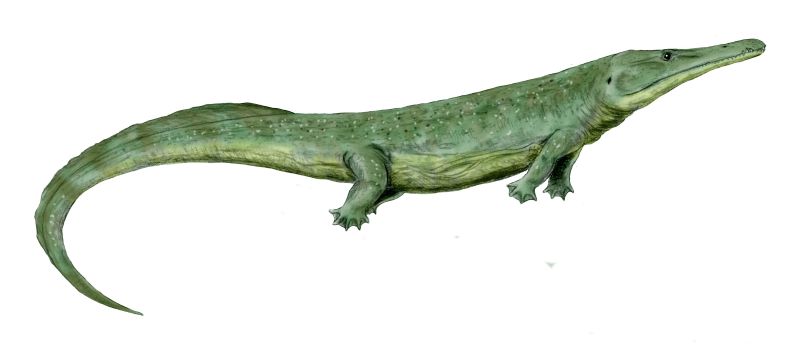[Recent Entries][Archive][Friends][User Info]
| Time | Text |
|---|---|
| 08:56 pm [Link] |
Prionosuchus Prionosuchus is a genus of extremely large temnospondyl amphibians from the Late Permian (270 million years ago) which was found in an area of what is now Brazil. The fragmentary remains of this animal have been found in the Pedra do Fogo Formation in the Parnaiba Basin of Northeastern Brazil, and it was described by L.I. Price in 1948. Reaching an estimated length of 9 m (30 ft), Prionosuchus is the largest amphibian ever found. With an elongated and tapered snout, numerous sharp teeth, long body, short legs, and a tail adapted for swimming, its general appearance was very similar to a modern crocodile, particularly to the gharial, and it probably had a similar lifestyle as an ambush aquatic predator feeding on fish and other aquatic animals. It has been classified as an archegosaurian by Carroll. The genus is monotypic with P. plummeri being the only species described. The archegosaurs were a group of temnospondyli that occupied the ecological niche of crocodiles and alligators during the Permian, and of which the European genus Archegosaurus is typical. The group went extinct at the end of the Permian and the niche was subsequently filled by reptiles such as the phytosaurs in the Triassic period. Cox and Hutchinson re-evaluated Prionosuchus in 1991 and synonymized it with the genus Platyoposaurus from Russia. On the basis of this study, the Pedra do Fogo Formation was reevaluated to be of Middle to Late Permian age. However, Platyoposaurus was comparatively smaller, reaching a total length of only 2.5 meters (8.2 ft), indicating that the two animals are distinct at least at the species level. Alternative studies based on plants and pollens indicate that this formation is rather of Early Permian age, making Prionosuchus not contemporary with Platyoposaurus. Most paleontologists consider Prionosuchus as a valid genus. Prionosuchus lived in a humid and tropical environment as indicated by the petrified forest of the Pedra do Fogo formation in which the fossil has been found. The strata composed of siltstones, shales and limestones were deposited in lagoonal and fluvial environments. Other animals discovered in the same rocks include fish (primitive sharks, palaeoniscids, and lungfishes) and amphibians. Интересно, что очень близкие к платиопозавру темноспондилы обнаружены в пермских отложениях Южной Америки. Первым из них был прионозух (Prionosuchus plummeri), описанный Л. Прайсом в 1948 году из пермских отложений Педра де Фого в Северной Бразилии. Первоначально найденные куски черепа принадлежали некрупным особям, но в 1970-х годах был обнаружен ростр прионозуха длиной около 80 см, что предполагает длину черепа более 160 см! Общая длина животного могла превышать 6 - 7 метров. Прионозух отличается чрезвычайно узким ростром. Череп пневматизирован, как у крокодилов. Мягкие ткани неба были покрыты костными пластинками, усаженными мелкими зубчиками. По-видимому, прионозух обладал короткими слабыми конечностями – возможно, он не покидал воду. Он мог населять крупные озера. Единственным другим ископаемым в слоях Педра де Фого является некрупная рыба Brazilichthys, представитель палеонисков. Не исключено, что прионозух относится к роду Platyoposaurus, но истинный возраст формации Педра де Фого не известен – он может быть и раннепермским, и позднепермским. Находки платиопозавров как в Северном, так и в Южном полушарии подтверждают существование в пермскую эпоху связи между Гондваной и северными континентами.
Размеры тела в сравнении с человеком:
|
| Reply: | |





